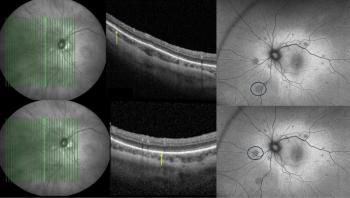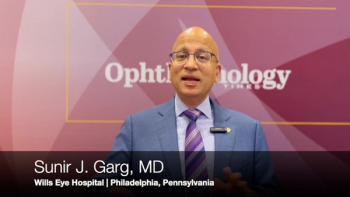
- Ophthalmology Times Europe March 2023
- Volume 19
- Issue 02
Keratoconus: Intrastromal implantation of fresh human lenticules
Stromal regeneration seems possible in patients with keratoconus.
Keratoconus (KC) is a bilateral, asymmetrical progressive ectatic disease of the cornea, resulting in corneal thinning, conical bulging, irregular astigmatism, and eventual Bowman layer breaks, hydrops and scarring.
The current surgical management of KC ranges from corneal collagen cross-linking (CXL) to intracorneal rings segments to alter the geometry of the cornea, and from lamellar (deep anterior lamellar keratoplasty) procedures to ultra-invasive corneal transplant surgery.
In the past decade, researchers have studied ways to reduce the risks of invasive procedures and have proposed several modifications to improve the outcomes; however, even when proven to be effective, these techniques may carry risk of complications risks or fail to address the two key parameters in keratoconic eyes, namely reduced pachymetry and induced irregular astigmatism or abnormal topography. Taking this into consideration, fresh myopic lenticule (FML) implantation is a promising novel technique.
A shift of focus
From its inception in the early 1990s, the femtosecond laser has opened a variety of surgical possibilities. Most ophthalmologists are accustomed to its application in the field of refractive surgeries. SMILE is a decade-old refractive laser procedure that is designed to treat a multitude of refractive errors such as myopia and myopic astigmatism within a certain range. In the future, it could also include hyperopia, presbyopia and astigmatism.
For myopia, this surgery consists of fashioning an intrastromal pocket using the femtosecond laser from which a circular lenticule of varying thickness is removed, thus achieving a thinner postoperative central corneal thickness, and correcting the patient’s refractive error by reducing the effective total refractive power of the cornea.
Some wondered if this precious tissue removed from the eye could be helpful in other settings, and several applications of these donor myopic lenticules have recently come to light. Lenticule implantation has been studied and is now a plausible surgical alternative for the treatment of conditions such as post-LASIK ectasia and pellucid marginal degeneration, correction of refractive errors such as hyperopia and astigmatism and even as patch grafts for corneal ulcers and perforations.1-4 Utilisation of lenticules for KC treatment found its way into a technique described by Sachdev et al for CXL patients with thin corneas,5 and Jacob et al have described a technique of implantation of corneal allogenic intrastromal ring segments, using donor corneal tissue from an eye bank and combining it with CXL.6 The technique was found to be stable, safe and effective.
Fresh lenticules as opposed to cryopreserved lenticules from an eye bank
In my practice I had several (patient) candidates for corneal transplantation surgery, with all the risks that such a procedure carries and some of the patients with thin corneas. I was looking for a technique that was less invasive while still addressing the reduced corneal thickness, the irregular astigmatism and the progression of KC.
In a study of 20 eyes reported in 2020, we described a technique of using FMLs for the treatment of KC.7 The aim was to investigate the feasibility of fresh lenticule implantation (taken from patients with myopia and implanted within 10 to 15 minutes from extraction) as allogenic graft in patients with KC. This study showed improvement in visual acuity (VA) and a statistically significant decrease in the corneal curvature readings. In the short-term follow-up period of 6 months, no complications or regression were noted.
However, the changes seen at the cellular level after implantation were still relatively unexplored, and the study findings encouraged us to further improve our understanding of this technique and evaluate the intrastromal histological structures that develop after FML intrastromal implantation.
Our next study recruited 60 eyes with such advanced KC that the patients were candidates for corneal transplantation. Initially, we removed a lenticular implant from donor patients (myopic and KC) who underwent SMILE surgery with a femtosecond laser (VisuMax; Carl Zeiss Meditec AG). The lenticules extracted from the donor eyes were implanted within a few minutes (still “alive”) in the 60 keratoconic eyes and followed up for 3 years. Small portions of the implanted lenticule were examined under a transmission electron microscope (TEM) at 1, 2 or 3 years after surgery and compared with the lenticule obtained from myopic refractive error controls and patients with KC.8
Normally, in corneas with KC, thinned and disorganised collagen fibres are found in the stroma along with degenerative stromal cells, and apoptotic bodies and cell debris are observed near the surrounding disorganised fibres. In contrast, in the eyes implanted with the fresh lenticules, the collagen fibre structures were well organised, and using the TEM we also observed well-organised parallel lamellar structures in the myopic refractive error.
In samples obtained 1, 2 and 3 years after lenticular implantation we found healthy keratocytes and telocyte-like cells, while apoptotic cells were almost absent. We noted that appropriate stimuli such as stem cells derived from fresh lenticules can activate telocyte-like cells and play an active role in stromal regeneration. These outcomes were aligned with significant improvements in VA and a general reduction in keratometry values.
In the past few years, several protocols have been proposed to use lenticules to treat corneal ectasia.
In ex and in vivo studies, Mastropasqua et al implanted lenticules from corneas of an eye bank into an intrastromal pocket and found that the keratocyte density was stable along with generic improvement of VA and keratometry readings.2-4 In contrast to the examination made in our cohort, they studied these corneas using confocal microscopy, but the increase in corneal thickness, decrease in anterior mean curvature on topography and improvement in VA are aligned with our findings.
Ganesh et al studied the flattening effects, refraction and safety results of tissue addition by femtosecond intrastromal lenticular implantation combined with CXL in patients with progressive KC: using cryopreserved lenticules, they observed clinical improvements for VA and a generalised flattening of mean keratometry.9 However, it is unclear what the contribution of CXL or lenticules implantation was in this cohort. A literature review by Fasolo et al found intrastromal lenticule implantation to be a suitable therapeutic option for the treatment of corneal ectasias, especially in patients with advanced KC.10 Nevertheless, they indicated that the accuracy and predictability of the refractive outcome is a critical issue and the patient eligible for the procedure still must be characterised.
Findings from several other studies demonstrated that intrastromal lenticule implantation is a safe and effective surgical option for advanced KC, a treatment option that is far less invasive compared with penetrating keratoplasty,11-13 but all those studies have so far used lenticules preserved in eye banks or decellularised by CXL.
It is our belief that FMLs, implanted within minutes of extraction, can start immediate stromal regeneration because those live lenticules contain live stem cells that produce keratocytes, telocyte-like cells, collagen fibres and the extracellular matrix.
Our study data also indicated that the cell-type telocyte-like cells may have the capacity and be useful for repairing a variety of corneal dystrophies, scars and injection site scars. We believe this to be the main novelty of fresh lenticules implantation and why the biological outcomes of our cohort show well-organised parallel lamellar structures and healthy keratocytes and telocyte-like cells 1, 2 and 3 years postoperatively. Live lenticules may have the capacity to activate stromal regeneration and repair damage.
We would like to explain the terminology of “fresh” as we use it: within minutes of extraction. In the literature,14 fresh has been used for lenticules that were stored in balanced salt solution for as long as 48 hours and we hypothesise this may reduce or even deactivate the regenerative capacity of the stem cells.
We are at the beginning of a long way to evaluate the effectiveness of this technique in a larger population sample. Yet, at present, fresh myopic intrastromal lenticular implantation is a safe, economical (it does not require laboratory support) and reliable technique that leads to increased corneal thickness; improved VA, as demonstrated in the literature; and the regeneration of the corneal tissue.
Faruk Semiz, MD
E: [email protected]
Dr Semiz is the head of the Department of Ophthalmology at the Eye Hospital Pristina in Kosovo. Dr Semiz has no financial disclosure with the products mentioned in this article.
References
Damgaard IB, Ivarsen A, Hjortdal J. Biological lenticule implantation for correction of hyperopia: an ex vivo study in human corneas. J Refract Surg. 2018;34(4):245-252
Mastropasqua L, Nubile M, Salgari N, Mastropasqua R. Femtosecond laser-assisted stromal lenticule addition keratoplasty for the treatment of advanced keratoconus: a preliminary study. J Refract Surg. 2018;34(1):36-44
Mastropasqua L, Salgari N, D’Ugo E, et al. In vivo confocal microscopy of stromal lenticule addition keratoplasty for advanced keratoconus. J Refract Surg. 2020;36(8):544-550
Mastropasqua L, Nubile M. Corneal thickening and central flattening induced by femtosecond laser hyperopic-shaped intrastromal lenticule implantation. Int Ophthalmol. 2017;37(4):893-904
Sachdev MS, Gupta D, Sachdev G, Sachdev R. Tailored stromal expansion with a refractive lenticule for crosslinking the ultrathin cornea. J Cataract Refract Surg. 2015;41(5):918-923
Jacob S, Patel SR, Agarwal A, Ramalingam A, Saijimol AI, Raj JM. Corneal allogenic intrastromal ring segments (CAIRS) combined with corneal cross-linking for keratoconus. J Refract Surg. 2018;34(5):296-303
Semiz F, Syla Lokaj A, Hima N, Semiz O. Corneal lenticule implantation in keratoconus disease with relex Smile surgery. Acta Scientific Ophthalmology. 2020;3(7):36-44
Semiz F, Lokaj AS, Tanriverdi G, Caliskan G, Hima-Musa N, Semiz CE. Fresh human myopic lenticule intrastromal implantation for keratoconus using SMILE surgery in a long-term follow-up study: ultrastructural analysis by transmission electron microscopy. J Refract Surg. 2022;38(8):520-528
Ganesh S, Brar S. Femtosecond intrastromal lenticular implantation combined with accelerated collagen cross-linking for the treatment of keratoconus—initial clinical result in 6 eyes. Cornea. 2015;34(10):1331-1339
Fasolo A, Galzignato A, Pedrotti E, et al. Femtosecond laser-assisted implantation of corneal stroma lenticule for keratoconus. Int Ophthalmol. 2021;(41):19491957
Wei Q, Ding H, Nie K, et al. Long-term clinical outcomes of small-incision femtosecond laser-assisted intracorneal concave lenticule implantation in patients with keratoconus. J Ophthalmol; 2022;2022:9774448
Doroodgar F, Jabbarvand M, Niazi S, et al. Customized stromal lenticule implantation for keratoconus. J Refract Surg. 2020;36(12):786-794
Jin H, He M, Liu H, et al. Small-incision femtosecond laser-assisted intracorneal concave lenticule implantation in patients with keratoconus. Cornea. 2019;38(4):446-453
Brar S, Ganesh S, Sriganesh SS, Bhavsar H. Femtosecond intrastromal lenticule implantation (FILI) for management of moderate to high hyperopia: 5-year outcomes. Journal of Refract Surg. 2022;38(6):348-354
Articles in this issue
almost 3 years ago
Making the diagnosis: Bilateral blurry vision in a 9-year-old boyalmost 3 years ago
Understanding Schlemm canal to improve the results of stent surgeryNewsletter
Get the essential updates shaping the future of pharma manufacturing and compliance—subscribe today to Pharmaceutical Technology and never miss a breakthrough.













































